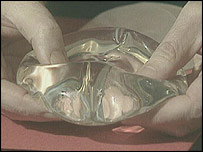
Many women do not
want artificial implants
Source: © 2004 BBC News Online
 Many women do not want artificial implants |
Doctors may have found a way to use a combination of a woman’s own fat and stem cells to make a natural breast implant, say Japanese researchers.
It is hoped that the method could prove an alternative to artificial implants filled with salt water or silicone.
Previous attempts to increase breast size with fat have failed because some of the tissue dies, forming hard lumps.
Adding stem cells could coax the growth of new blood vessels, say experts from the University of Tokyo.
The patient’s fat reserves are often raided by cosmetic surgeons to provide raw material to smooth out facial wrinkles or cover up scars.
However, the sheer quantity of tissue needed to bulk out the breast has been the stumbling block.
However, Dr. Kotaro Yoshimura believes he has found a way to create the desired effect with no complications, reports the Nature website.
During the operation, surgeons suck fat cells from the stomach or thigh, and this “slurry” is enriched so that there are higher numbers than usual of stem cells.
These are “master” cells which are capable of making new fat cells.
When the enriched stem cell mixture is combined with normal fat tissue, it can then be injected into the breast area.
Using the woman’s own tissue has a number of potential advantages – not only do few patients object to losing fat from around the thighs or stomach, but the tissue has no chance of being rejected by the immune system.
Eventually, artificial implants may have to be removed to ensure the patient is safe in the long term.
The Japanese team has carried out the procedure on his first patient last month, and hopes to complete dozens more operations.
Marc Hedrick, of the University of California, Los Angeles, and chief scientific officer for MacroPore Biosurgery in San Diego, California, told Nature: “There’s a good shot that this will work.”
However, plastic surgeon Adam Katz, of the University of Virginia, Charlottesville, told the journal more animal trials were needed before widespread use of the technique in human patients.